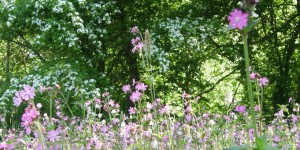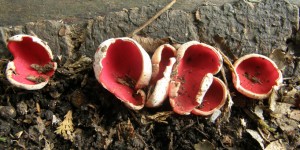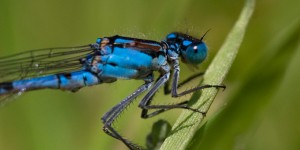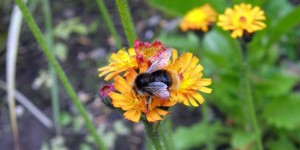Designated a Site of Local Importance for Nature Conservation (SLINC), we are proud to have such a rich habitat for local wildlife.
Martineau Gardens is part of a larger nature conservation area including Beechwood hotel (SLINC), Edgbaston Park Golf Course (SINC), Edgbaston Grove Woodland (SINC), the Vale and the Rea Valley. The latter two are also designated as Wildlife Corridors. What is Biodiversity & a SLINC
We have a Nature Trail (created March 2011) and a Nature Trail Guide which explains how the Gardens are managed for the benefit of wildlife and details what habitats can be seen and what species visit.
Our bird hide is located within our wildlife area – read this article (from the Winter newsletter of the RSPB Sutton Coldfield Local Group, with kind permission) for an insight to bird sightings at Martineau Gardens.
While Martineau Gardens is not renowned for bird sightings it does have the secluded location and habitats to attract rarer one-off sightings such as woodcock, willow (or was it a marsh) tit, kestrel, peregrine falcon, as well as one sighting of a red kite!
For wildlife news from Martineau Gardens, click here.
Habitats
Hedgerow – There are several areas of hedgerow at Martineau Gardens. Some of these were “laid” in 2006 – 2007 by volunteers and wildlife experts. Hedge laying is a traditional way of creating barriers, originally used to keep in livestock. It includes cutting almost all of the way through a tree, and then leaning the tree over. When this is done to a row of trees, and they are secured in place with stakes and binders, it creates a living hedge which is extremely beneficial for wildlife. Some of our hedges have not been laid yet, as they were planted this year. It will be some years before these are mature enough to be laid. Hedges provide cover for birds and mammals, and often are a source of food (holly, hazel, etc.).
 Wildflower Meadow – Over 95% of Britain’s wildflower meadows have disappeared in recent years. They are an amazing resource for wildlife, particularly insects such as bees and butterflies. In 2006 we created two meadows: A summer meadow behind the shipwreck and a spring meadow in front of it. Turf was stripped and a mix of native wildflower seeds and grasses.
Wildflower Meadow – Over 95% of Britain’s wildflower meadows have disappeared in recent years. They are an amazing resource for wildlife, particularly insects such as bees and butterflies. In 2006 we created two meadows: A summer meadow behind the shipwreck and a spring meadow in front of it. Turf was stripped and a mix of native wildflower seeds and grasses.
Meadows are easy to create, but require management, so a regime of cutting and raking at specific times of the year will create a diverse and beautiful part of the wildlife area.
In 2007 we extended the summer meadow, which now reaches up to edge of the woodland, and we are looking forward to watching it develop over the next few years.
 Dead Wood – Dead wood is one of our most vital, yet often overlooked types of habitat. Invertebrates that thrive in areas of damp, decaying wood are the base of the food chain. A healthy invertebrate population is a food source for insect-eating birds, mammals and amphibians. Dead wood also provides hibernation spaces for newts and toads.
Dead Wood – Dead wood is one of our most vital, yet often overlooked types of habitat. Invertebrates that thrive in areas of damp, decaying wood are the base of the food chain. A healthy invertebrate population is a food source for insect-eating birds, mammals and amphibians. Dead wood also provides hibernation spaces for newts and toads.
Here at Martineau Gardens, you may see piles of wood here and there throughout the woodland. Many of these have been created specifically with animals in mind. Decaying wood is also the best place to look for many forms of fungi, especially in the autumn.
Woodland – Our woodland here at Martineau Gardens is dominated by mature oak trees, but you will also find Hazel, Alder, Mountain Ash, Silver Birch, Holly, Guelder Rose, Yew and Beech. The woodland has undergone some changes this year, which include the removal of non-native species, the joining up of parts of the woodland by closing of one of the paths, and the planting of native species of trees and flowers. Much of the work done has increased the amount of light that gets to the ground, which we hope will increase the number of species of woodland flowers and plants, and thus encourage woodland insects, including butterflies. Many species of mammals and birds use the area to live, breed and forage. Some of our bird species include: Nuthatch, Bullfinch, Long-tailed tit, Chaffinch, Goldcrest and all three species of British Woodpecker. We are constantly trying to improve and create habitat, so you will see numerous bird boxes, insect homes and bat boxes throughout the area. We also have a resident colony of pipistrelle bats, which have a summer roost in one of our oak trees.
 Pond – Woodland ponds are fantastic habitat for wildlife. As well as supporting a myriad of freshwater invertebrates such as Pond Skaters, Water Measurers, Diving Beetles, Water Boatmen and Snails, they are invaluable for other animals as a source of drinking and bathing water. A Sparrowhawk has even been seen taking a bath in our woodland pond. We also have a population of smooth newts which rely on our pond for breeding in the spring.
Pond – Woodland ponds are fantastic habitat for wildlife. As well as supporting a myriad of freshwater invertebrates such as Pond Skaters, Water Measurers, Diving Beetles, Water Boatmen and Snails, they are invaluable for other animals as a source of drinking and bathing water. A Sparrowhawk has even been seen taking a bath in our woodland pond. We also have a population of smooth newts which rely on our pond for breeding in the spring.
 Flower Beds – Even if you do not have your own nature area, you can still create habitat for wildlife in your garden. Amazingly, our 2006 insect survey showed that we had more flying insects in our flower beds than anywhere else on site. This is powerful evidence of the beneficial effect that planting for wildlife can have. All of our gardening here at Martineau Gardens uses organic principles, so that our produce is not only healthy for humans to eat, but it has a positive effect on wildlife.
Flower Beds – Even if you do not have your own nature area, you can still create habitat for wildlife in your garden. Amazingly, our 2006 insect survey showed that we had more flying insects in our flower beds than anywhere else on site. This is powerful evidence of the beneficial effect that planting for wildlife can have. All of our gardening here at Martineau Gardens uses organic principles, so that our produce is not only healthy for humans to eat, but it has a positive effect on wildlife.
